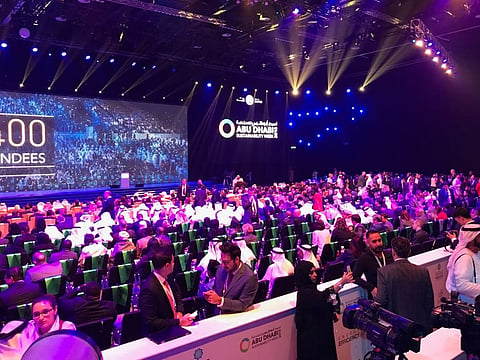Video: Blue LED inventor Shuji Nakamura wins Zayed Future Energy Prize
Shuji Nakamura, inventor of blue LED, wins Zayed Lifetime Achievement; winners named from 2,296 submissions received from 112 countries

Abu Dhabi: Shuji Nakamura, the Japanese inventor of the blue LED light, was named given a Lifetime Achievement here in recognition of his pioneering work that has revolutionised lighting across the world.
The Japanese inventor, who was awarded the 2014 Nobel Prize in Physics for inventing the blue light-emitting diodes (LEDs), was honored at the Zayed Future Energy Prize awards ceremony on Monday as part of Abu Dhabi Sustainability Week.
This year’s edition of the prize – its 10th anniversary – having received 2,296 submissions from 112 countries around the world.
Launched in 2008, the Zayed Future Energy Prize aims to support and encourage sustainable projects around the world, with the prize having impacted 289 million people through its projects.
His Highness Shaikh Mohammad Bin Zayed Al Nahyan, Crown Prince of Abu Dhabi and Deputy Supreme Commander of the UAE Armed Forces, attended the ceremony handing out the awarding certificates to the winners.
The prize is split into five categories – Global High Schools, Non Profit Organisation, Small and Medium Enterprises, Large Corporation, and the Lifetime Achievement — with prize values ranging from $500,000 to $1.5 million excluding the large corporation category.
Global High School winners
Asia: Bahrain Bayan School, Bahrain
Oceania: Motofoua Secondary School, Tuvalu
Africa: Aouda Saadia High School, Kingdom of Morocco
Americas: Centro Educativo Mbaracayu, Republic of Paraguay
Europe: Vladimir Nazor School, Republic of Croatia.
Non Profit Organisation winner: Selco Foundation, India
Small and Medium Enterprise winner: Sunna Design, France
Large Corporation winner: Google
Lifetime Achievement winner: Shuji Nakamura, inventor of LED lights, Japan
Who is Shuji Nakamura?
Born on May 22, 1954, in Ehime, Japan, Nakamura is a Japanese-born American materials scientist.
Prof. Shuji Nakamura is the inventor of the blue LED. Since 2000, he has been a professor of Materials and Electrical & Computer Engineering at the University of California, Santa Barbara. .
Nakamura received bachelor’s (1977) and master’s (1979) degrees in electronics engineering from the University of Tokushima.
Nakamura developed the blue light-emitting diodes (LEDs). Scientists had produced LEDs that emitted red or green light, but attempts to make blue LEDs were unsuccessful.
If developed, the blue LED could be combined with red and green LEDs to produce white light for a fraction of the cost of incandescent and fluorescent lighting.
In 1992, he successfully developed the techniques to produce efficient blue LEDs.
In 1994 Nakamura received a doctorate in engineering from the University of Tokushima. He then worked on producing a blue laser diode using gallium nitride. In 1995 he was successful which led to the widespread use of blue laser diodes.
In 2000, Nakmura became a professor in the materials department of the University of California, Santa Barbara.
Prof. Nakamura holds more than 200 US patents and over 300 Japanese patents. He has published over 550 papers in his field.
In 2014, he was awarded the Nobel Prize in Physics for inventing the blue LED, which he shared with Japanese materials scientists Akasaki Isamu and Amano Hiroshi.
Sign up for the Daily Briefing
Get the latest news and updates straight to your inbox


